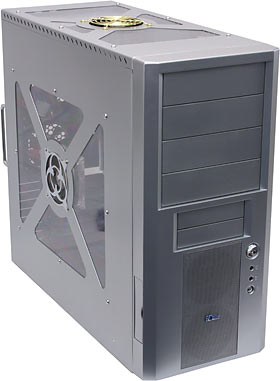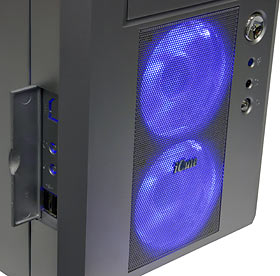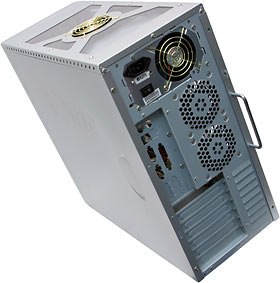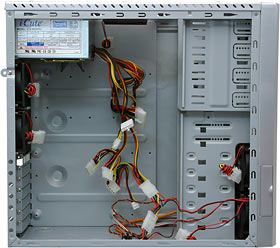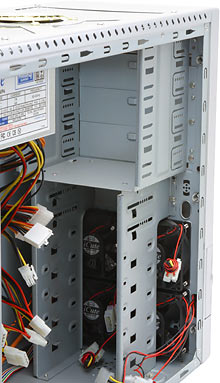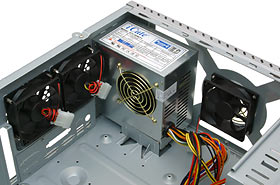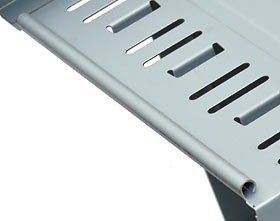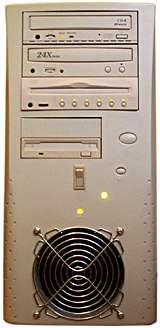
GTR iCute 0301 PC case
Review date: 17 December 2003.Last modified 03-Dec-2011.
Do you like fans?
Do you like a lot of fans?
Do you like a whole lot of fans?
Have I got a PC case for you.
This, according to the side of its box, is the GTR (GTR, of course, stands for Genteelord International Limited. Don't ask questions) iCute 0301SL-SS-3B. It's a budget priced, pretty good looking show-off PC case for ATX and microATX motherboards, with windows on the side and the top to show off your stylin' PC components.
And it's got 80mm fans.
TWELVE of them.
This is counting the two fans in the Power Supply Unit, but since the PSU is part of the package, I think that's fair.
Heck, even ten fans is about six more than you expect to see in even a tweaky aluminium PC case, much less a cheapie like this one.
Here in Australia, Aus PC Market sell the 0301SL for $AU154 including Sydney metropolitan delivery - delivery elsewhere in the country costs more.
There are apparently at least two variants of the 0301 case, but Aus PC only stock this silver one. I think it'll do.
For your money, you get a case that's made of steel, not the more expensive aluminium. And, viewed in purely utilitarian terms, it's not got as many features as boring beige cases at the same price point.
This case is not, however, aimed at that portion of the market that likes beige.
The two front intake fans (number 1 and 2...) are stacked, and lit up by blue LEDs. The glow diffuses pleasingly through the front grille; there's also the usual cut-out at the bottom of the front bezel, to let a bit more air in. That's a good thing, given how many other air-shifters need to be fed.
There's no foam filter on these fans, or on any of the others in the 0301. It doesn't have much more ground-level intake power than many other cases, though, so I doubt it'll clog itself with dust particularly quickly.
Note the side USB ports in the above picture, as well. There are punch-outs behind the same little hinged door for two audio connectors and one FireWire socket, but all that's installed is the USB ports.
The USB port leads inside the case terminate in double plugs, one with three pins and one with only one. This ought to be compatible with most motherboards that have USB port headers on them, but different motherboard manufacturers have had different brilliant ideas about how USB headers should be implemented, so you're on your own.
There's nothing very remarkable on the back panel, besides the fact that the two rear exhaust fan grilles both come with a fan pre-installed (fans 3 and 4...). Many cases have a couple of rear fan locations, but it's common to only find a fan on one of them.
You can see the top fan (#5...) in this picture, too. It's set up as another exhaust fan, but you can flip it around to make it an intake if you like. It's held in place with standard large-pitch screws.
The side panel has a padlock tab, which is common, and a large pull-handle, which is not. I like the handle; it makes the panel easy to deal with, despite the extra bulk of the window and side fan assembly.
That side fan (#6...) lights up, too. Of course. It's set up as an intake.
The side fan, and every other fan in this case, is powered by a passthrough Molex adapter, so you don't have to use up a PSU plug. This is a good thing, as we'll see in a moment.
Whip off the side panel, and you're greeted with a pretty normal cheap steel case interior. Four 5.25 inch bays, two 3.5 inch bays with front panel cutouts, four more 3.5 inch bays behind the front fans. The drive bays are all riveted in place; you can't lift them out for easy installation.
You won't be able to use all of those bays for drives if you use the standard PSU - well, not without a few Y-adapters and some luck, anyway.
The stock PSU is an unassuming 350 watt unit - but yes, its rail ratings do actually add up to 350 watts. This isn't one of those swindling PSUs that can only manage its quoted total power if you add the limits for each individual rail when it's the only one that's doing anything.
A 350 watt rating is enough for a quite seriously stacked PC (a quality 300W PSU will do for most systems), but this PSU only has four Molex plugs and two floppy plugs, in addition to the usual ATX, ATX12V and Aux connectors.
If you just plug all of the fans in higgledy-piggledy and leave the cables to hang where they will, this case will thus end up presenting a world class rat's nest of wires to anyone who peers through the side window.
If you're not installing a bunch of drives, though, a bit of thought and a few cable ties should let you set up a decently tidy arrangement.
But wait - I still haven't shown you all of the fans!
Here are four more (numbers 7 through 10...). They're on the other side of the front panel from the two glowy intake fans, which means they fight over the airflow less than you'd think. This arrangement still isn't going to win any awards for air flow efficiency, but it's not just decorative; the six intake fans do actually all achieve something.
And here's the PSU's bottom intake fan, which along with its rear exhaust fan brings the total up to the abovementioned twelve.
Pros and cons
You may be wondering, at this point, whether this case sounds like something into which you insert trees and out of which shoots mulch. Surprisingly, it doesn't. I've actually heard plenty of louder cases that have less than half of the 0301's ventilation fan count.
The reason for this is that all of these fans are very low power units. The black fans all have a current rating of only 0.1 amps, which means their run power is unlikely to be much more than a watt. The glowy fans don't have specs on their stickers, and they'll draw a bit more power to run their LEDs, but they're no louder than the black fans.
A Silent Computing Solution, this case is not. But lots of people put up with much noisier PCs.
What this case definitely is, though, is a fan bearing MTBF research laboratory conveniently powered from one ATX lead.
Trial-and-error tweakers without access to laboratory refrigerators have been turning PCs into fan farms since the days when a K6 was the chip to have. Many of them have discovered that a bunch of cheap sleeve bearing fans, like the ones that infest this case, can turn into a bit of a maintenance adventure.
It's seldom very dangerous when a bearing starts chattering - it'll probably make an annoying noise for some time before it seizes completely, and even if it does seize, the fan motor won't catch fire as a result. If it's just one ventilation fan among many, not the fan on the CPU heat sink, then a failed fan is unlikely to poleaxe the whole PC.
You can also oil the bearings (don't tell me you've got anything better to do on Saturday night) to delay the onset of this problem, and possibly extend the bearing life indefinitely. But most people just wait for a failure and then swap out the fan.
If you run your PC 24/7, I wouldn't be surprised if a machine built in this case needed some fan-swapping after a year or two - and needed another fan swapped mere weeks after the first one, and so on.
If you're enough of a geek that this case excites you in the first place, though, this isn't likely to deter you. And because the low power fans in this box don't spin too fast, their lifespan may be surprisingly long anyway. Some super-cheap sleeve bearing fans soldier on for year after year of constant service. That's just not the way to bet.
I'm happy to report that within its limits, the 0301 also isn't too hard to work on. It's got no slide-out motherboard tray or removable drive cages, but if you're only installing a few drives and not swapping stuff in and out every second day then you'll be fine.
Every PC-wrangler's pet hate is the really dirt cheap pressed steel case, with its plethora of 87 and 93° angles, and steak-knife panel edges.
The 0301 is not like this. Its fit and finish are OK; not hand-built-in-Crewe quality, but perfectly all right. And its panel edges are rolled.
Sometimes very rolled.
Overall
Show-off PC cases with windows and lights are fun. A lot of people aren't sufficiently dedicated to the cause, however, that they want to invest a lot of time or money in order to end up with a light-up PC. The iCute 0301 could have been made for people like this.
The 0301 is also at least somewhat practical. It's easy enough to work on, and nobody can claim that it doesn't have excellent ventilation. That's good news for plain old system stability as well as overclockability, especially if your computer room's ambient temperature gets high from time to time.
If you don't need the 0301's frills, then you'll get more features per dollar if you drop about the same money on a nice boring AOpen box. There are lots of good beige steel cases around this price point.
The iCute 0301SL-SS-3B, however, definitely has its place. I think it'll be lighting up the underside of a lot of desks quite soon.
Buy one!
Aus PC Market no longer stocks exactly this version of the 0301, but they
do have a black version, with no PSU, for only $AU88 including Sydney
metro delivery.
Click here to order it!
(if you're NOT from Australia or New Zealand,
Aus PC Market won't deliver to you. If you're in the USA, try a price search
at
DealTime!)
